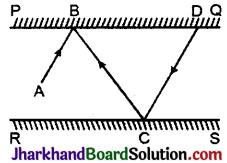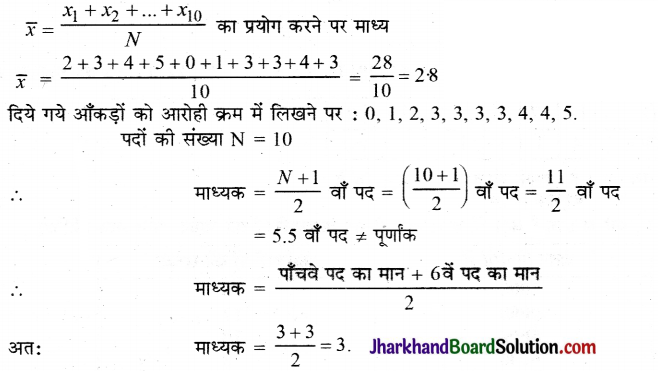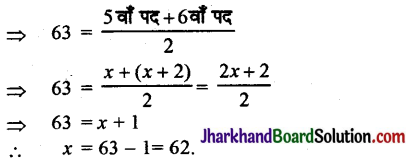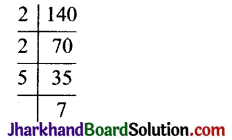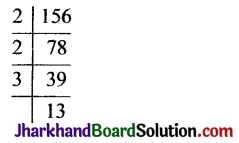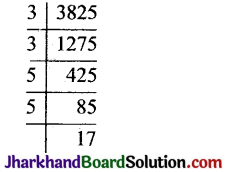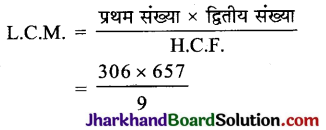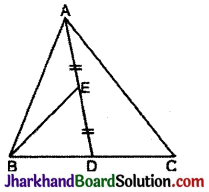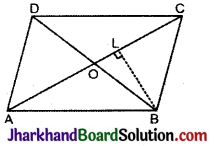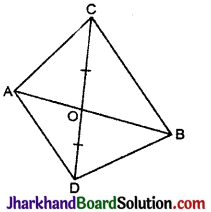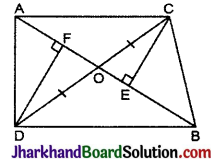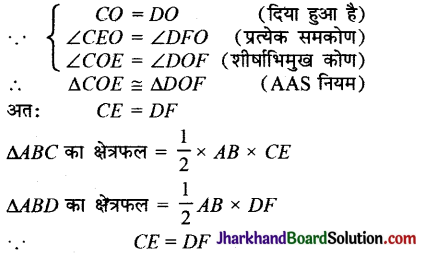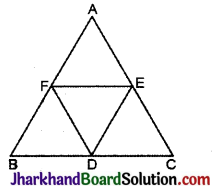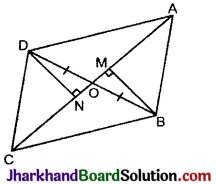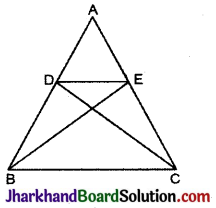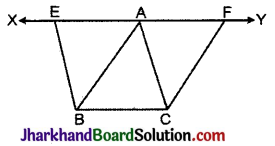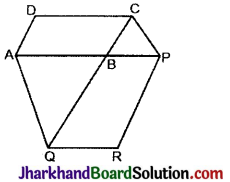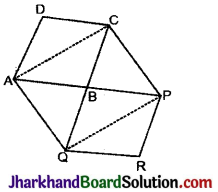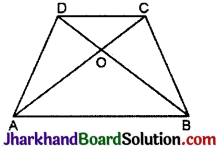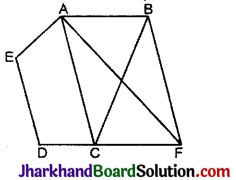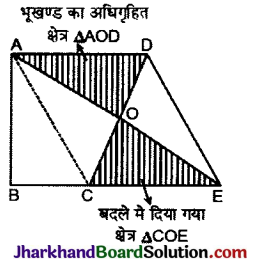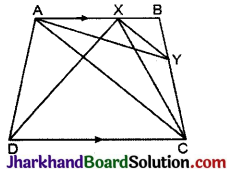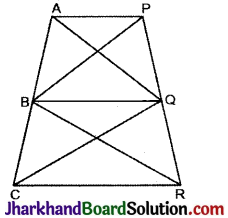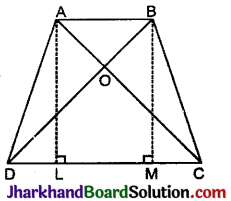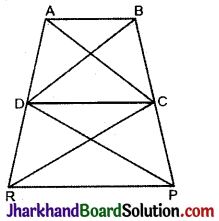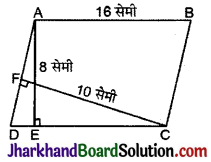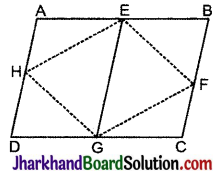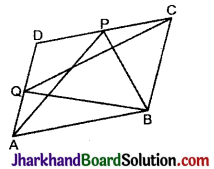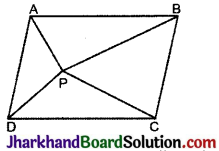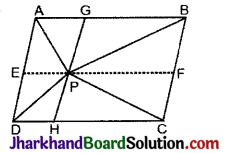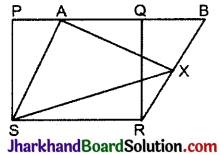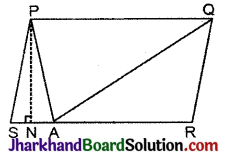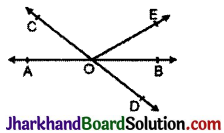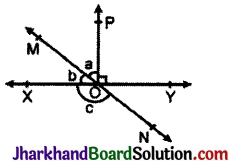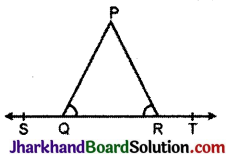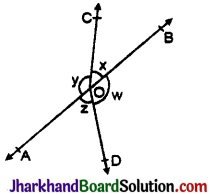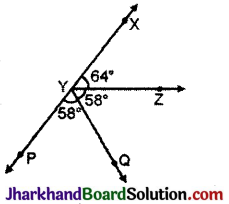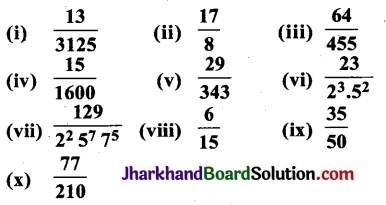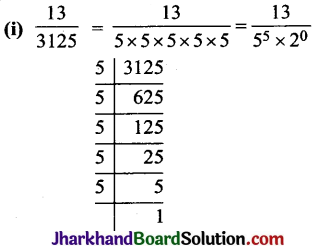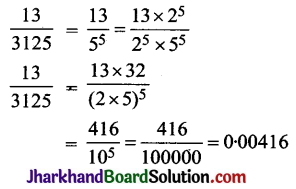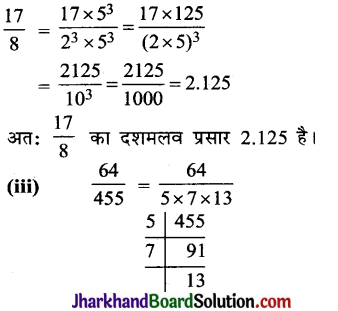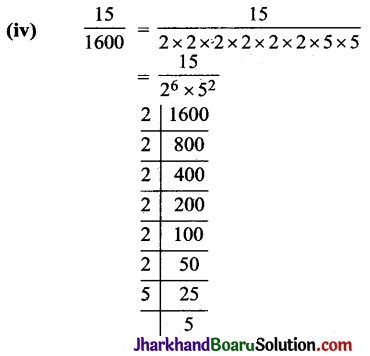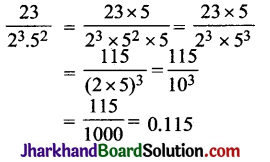Jharkhand Board JAC Class 9 English Solutions Reading Comprehension Unseen Passages Questions and Answers.
JAC Board Class 9 English Reading Comprehension Unseen Passages
Unseen Passage के प्रश्नों का उत्तर लिखते समय ध्यान देने योग्य बातें –
- Comprehension शब्द का अर्थ understanding या ‘समझना’ होता है । अतः passage को ध्यानपूर्वक पढ़कर समझना चाहिए ।
- Passage में कुछ कठिन शब्दों के अर्थ स्पष्ट न होने पर घबराना नहीं चाहिए । जो शब्द समझ में आते हों उन्हीं के आधार पर गद्यांश का सही अर्थ समझने का प्रयत्न करना चाहिए ।
- प्रश्न जिस Tense में पूछा जाए, उत्तर भी सदैव उसी Tense में दिया जाना चाहिए।
- उत्तर में उतनी ही बात लिखनी चाहिए जितनी कि पूछी गई हो, उससे कम या अधिक नहीं ।
- Passage में पूछे गये questions सामान्यतया निम्नलिखित Question-words से प्रारम्भ होते हैं, जिनके अर्थ तथा आशय निम्न प्रकार हैं –
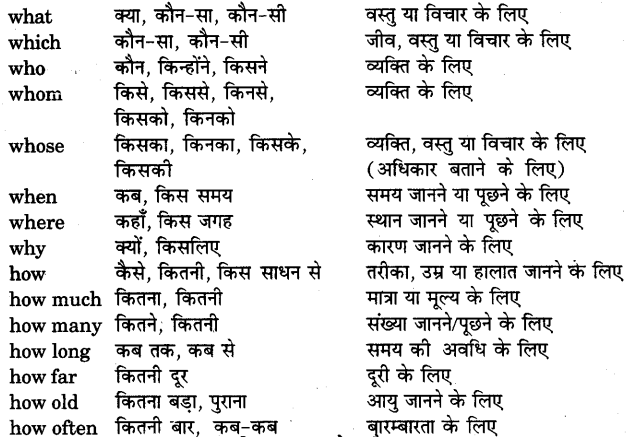
प्रश्न का patterr सामान्यत: निम्न प्रकार होता है –
Question-word . Helping Verb + Subject + Verb + ?
उत्तर Question-we d को छोड़कर Subject से प्रारम्भ करते हैं, फिर Helping Verb तथा फिर उत्तर के शेष भाग को लिखते हैं । जैसे –
Que. What is Ram doing?
Ans. Ram is playirg on the piano.

विशेष :
(i) जिन प्रश्नों में Helping Verbs do, does, did का प्रयोग होता है, उनके उत्तरों में इन Helping Verbs का प्रयोग नहीं होता । does की स्थिति में क्रिया में s / es लगाते हैं, do की स्थिति में क्रिया का First Form ( बिना s / es ) रखते हैं तथा did की स्थिति में क्रिया का Second Form रखते हैं। जैसे –
Que. Where does Ragini live ?
Ans. She lives in Delhi. (….does….live = lives)
Que. How did you go to Mumbai?
Ans. I went to Mumbai by air. (….did….go = went)
(ii) यदि प्रश्न Negative में हो तो इन्हीं Helping Verbs (do, does, did) को उत्तर में लिखा जाता है । जैसे-
Que. What do you not take for breakfast?
Ans. I do not take tea for breakfast.
Que. Why didn’t you get up earlier ?
Ans. I didn’t get up earlier because I had gone to bed late.
(iii) Why से प्रारम्भ होने वाले प्रश्नों के उत्तरों में Connective के रूप में प्रायः because का प्रयोग किया जाता है। कुछ उत्तरों में Infinitive (to + Verb) का प्रयोग किया जाता है । जैसे –
Que. Why did Ram kill Ravan?
Ans. Ram killed Ravan because the latter had kidnapped the former’s wife, Sita.
Que. Why did you go to Agra?
Ans. I went to Agra to see the Taj Mahal.
(iv) जिन प्रश्नों के मध्य में there का प्रयोग किया जाता है, उनके उत्तर प्रायः There से ही प्रारम्भ होते हैं । जैसे
Que. How many members are there in your family?
Ans. There are three members in my family.
Que. How much milk was there in the pot?
Ans. There was a little milk in the pot.

(v) आपको गद्यांश (passage) के मुख्य विचारों से ही अवगत होना है, यह आवश्यक नहीं कि पढ़ते समय प्रत्येक शब्द समझ में आ जाये।
(vi) प्रश्नों का उत्तर सटीक होना चाहिए । जहाँ तक हो अपने शब्दों तथा सरल वाक्यों में उत्तर देना अच्छा रहता है |
Unseen Passage
Read the passages given below and answer the questions that follow :
Passage 1.
One day the Giant came back. He had been to visit his friend, the Cornish Ogre, and had stayed with him for seven years. When he arrived he saw the children playing in the garden. “What are you doing here ?” he cried in a very gruff voice, and the children ran away. “My own garden is my own garden,” said the Giant; “anyone can understand that, and I will allow nobody to play in it but myself”. So he built a high wall all round it, and put up a notice-board :
Trespassers Will Be Prosecuted
He was a very selfish Giant.
The poor children had now nowhere to play. They tried to play on the road, but the road was very dusty and full of hard stones and they did not like it. They used to wander round the high walls when their lessons were over, and talk about the beautiful garden inside. “How happy we were there!” they said to each other.
Questions :
1. Who came back ?
2. How long did the Giant stay with his friend Cornish Ogre ?
3. What did the Giant find on his return?
4. What did the Giant do when he returned?
5. Why did the children run away?
6. What was written on the notice-board ?
7. What did the Giant not like ?
8. Why were the children sad?
9. Find out from the passage the words that are similar to :
(i) roam (ii) rough.
10. Make adverbs of the following words :
(i) high (ii) beautiful
Answers:
1. The Giant came back.
2. The Giant stayed with his friend Cornish Ogre for full seven years.
3. On his return the Giant found the children playing in his garden.
4. When the Giant returned, he built a high wall all around the garden.
5. The children ran away because the Giant had returned.
6. “Tresspassers will be prosecuted” was written on the notice board.
7. The Giant did not like the children to play his garden.
8. The children were sad because they could not play in the garden.
9. (i) wander (ii) gruff.
10. (i) highly, (ii) beautifully
Difficuit words : Cornish Ogre = कार्नवाल का एक राक्षस ।gruff = रूखी (आवाज) ।trespassers = अवैध प्रवेश करने वाले । will be prosecuted = दण्डित किए जायेंगे । dusty = धूल भरा । wander = घूमना।

Passage 2.
In Naini, there lived a poor boy named Anil. He had polio, so he limped. He was a simple boy with a smiling face. All the villagers loved him a lot. There was a temple in the forest. There was a big brass bell. One day, a thief stole the bell. He took it to a cave nearby and hung it there. However, while he was returning, he was killed by a tiger.
One day a group of monkeys entered the cave. They started using the bell as a swing. In the process, the bell pealed loudly all day. The villagers wondered what the matter was. It was a mystery. The next morning, five of the villagers set out on the journey. When they reached the dense forest, they saw the skeleton of the thief and others who had been killed by the tiger. Considering this to be the work of a man-eating giant, they fled back to the village.
The village was filled with fear. Anil also heard about the man-eating giant. He was a brave boy. He decided to solve the mystery of the man-eating giant.
Questions :
1. Who was Anil ?
2. Where was the temple situated ?
3. What did the monkeys do ?
4. What did the villagers do to solve the mystery ?
5. Who lived near the cave ?
6. What did Anil decide ?
7. What did the villagers see when they reached the forest?
8. What did the thief do one day ?
9. Write down from the passage the words which mean the same as :
(i) started (ii) burglar
10. Bring out the meanings of the following words by making separate sentences from them :
(i) wonder (ii) mystery
Answers:
1. Anil was a poor.
2. The temple was situated in a forest.
3. The monkeys used the bell as a swing.
4. Five villagers went to the forest.
5. A group of monkeys lived on near the cave.
6. Anil decided to solve the mystery of the man eating giant.
7. They saw the skeleton of the thief and others.
8. One day the thief stole the big brass bell.
9. (i) set out (ii) thief
10. (i) wonder = want to know something – I wonder what the new teacher will be like.
(ii) mystery = the thing that you cannot explain – The cause of the accident is a mystery.
Difficult words : limped = लंगडा कर चलता था । a lot = बहुत सारा । smiling = मुस्कराते हुए । brass = पीतल । cave = गुफा। swing = झूला । pealed = rang continuously, निरन्तर बजता रहता था । mystery = रहस्य, भेद । set out = started, चल दिया । skeleton = कंकाल ।

Passage 3.
Gandhi wanted to cut down his expenses on washing. One day, he came home with all the things needed to do his own washing and starching. He also bought a book on washing and read it carefully. Gandhi taught his wife Kasturba the art of washing.
The new hobby was an additional burden on Gandhi’s daily work, but he was not a man to give up. He was determined to cut down his expenses. He also wanted to be self-reliant.
One day, he washed a collar and starched it. Since he was not used to ironing, he used an iron that was not hot enough, and he did not press hard enough. He was afraid of burning the collar.
He went to the court wearing the collar. It was over-starched and stood stiff. His friends laughed quietly at this sight. Gandhi was not disturbed and said, “Well, this is my first attempt at washing, hence this overdose of starch. But it does not matter. At least it provided you with so much fun!”
Questions :
1. Why did Mahatma Gandhi start washing and ironing clothes with his own hands?
2. What did his fellow lawyers do to see his collar?
3. How did Gandhiji react to his fellow lawyers’ funny remark?
4. Why did Gandhiji buy a book on washing?
5. What did Gandhiji teach Kasturba?
6. What was an additional burden on Gandhiji’s daily work?
7. For what was Gandhiji determined ?
8. What made the collar stiff?
9. Write one word for ‘an activity that is done for pleasure when we are not working’.
10. Select words from the passage which mean opposite to the following words :
(i) carelessly (ii) advantage
Answers:
1. Mahatma Gandhi started washing and ironing his clothes with his own hands because he wanted to cut down his expenses on washing.
2. His fellow lawyers laughed to see Gandhiji wearing an overstarched and roughly ironed collar.
3. Gandhiji plainly said that it was his first attempt at washing.
4. Gandhiji bought a book on washing because he wanted to learn washing.
5. Gandhiji taught Kasturba the art of washing.
6. His new hobby was an additional burden on Gandhiji’s daily work.
7. Gandhiji was determined to cut down his expenses.
8. Over dose of starch made the collar stiff.
9. hobby
10. (i) carefully (ii) burden
Difficult words : collar = white neck band worn by lawyers, वकीलों द्वारा गले में पहिना जाने वाला कॉलर । used = (यहाँ) पहनते थे । expenses = money spent for a particular purpose, खर्चे । hobby = something that you do regularly for pleasure in your free time, शौक । determined = पक्का इरादा किया। self-reliant = able to do things for oneself, आत्मनिर्भर । used to ironing = आयरन करने के अभ्यासी । over-starched = ज्यादा कलफ लगा हुआ । stiff = firm and difficult to bend or move, सख्त, कड़ा और न झुकने या मुड़ने वाला । stood stiff = अकड़ा हुआ । quietly = silently, चुपचाप । disturbed = परेशान । hence = so, इसलिए । overdose of starch= आवश्यकता से ज्यादा कलफ लगना।

Passage 4.
Once upon a time, Jhubbu, a stray dog, used to go into the stable where Appu, the king’s elephant lived. At first, Jhubbu went there to get the food that Appu didn’t finish. Day after day, Jhubbu went to the stable, looking for bits to eat. By and by, Appu and Jhubbu came to be close friends. Appu began to share his food with Jhubbu, and they always ate together. Neither was happy unless the other was nearby. Appu’s keeper did not like Jhubbu, and he thought it a good idea to sell him. So he sold it for a small amount of money to a farmer.
Appu missed Jhubbu and did not want to eat without his friend. The king was told about it. The king sent for his chief servant. The chief servant went to the stable and examined Appu. Then he went back to the king and said, “Appu is not sick, but he is lonely without his friend, Shubbu.”
The king bought back Jhubbu. Appu was so happy to see Jhubbu that he picked him up with his trunk and put him on his head. Then he put him down gently again.
Questions :
1. Who was Jhubbu ?
2. How did Jhubbu become friend of Appu, the king’s elephant?
3. What did the keeper do to get rid of Jhubbu ?
4. How did Appu react to Jhubbu’s absence?
5. How did Jhubbu come back ?
6. Who took Jhubbu away?
7. What did Appu do when he saw Jhubbu again?
8. What did the chief servant inform the king?
9. Find out from the passage words which mean the same as :
(i) lifted (ii) aloof
10. Rewrite the following sentence by changing it from direct to indirect:
The chief servant said to the king, “Appu is not sick.”
Answers:
1. Jhubbu was a stray dog.
2. Jhubbu régularly visited Appu’s stable for left over from Appu’s foods. The elephant and the dog played together and became friends.
3. The keeper sold the dog Jhubbu to get rid of the dog.
4. In the Jhubbu’s absence the elephant became sad and refused to take any food.
5. The king bought Jhubbu back.
6. A farmer took Jhubbu away.
7. When Appu saw Jhubbu, he became so happy that he picked him up with his trunk and put him on his head.
8. The chief servant informed the king that Appu was not sick but he was lonely without his friend.
9. (i) picked (ii) lonely
10. The chief servant told the king that Appu was not sick.
Difficult words : stray = homeless, जगली । stable = home or shelter for animals, जानवरों के रहने का स्थान । by and by = in a little time, धीरे-धीरे । came to be close friends = पक्के मित्र हो गए missed = अभाव खलता था । sent for = called, बुलाया । lonely = अकेला । picked him up with his trunk = अपनी सूँड़ से उठाया । put him on his head = seated him on his head, अपने सिर पर बिठाया।

Passage 5
Jumman Sheikh and Algu Choudhary were good friends. Both were greatly respected in the village. Jumman had an old aunt who had some property. This she transferred to him on the understanding that she would stay with him and he would look after her. The arrangement worked well for a couple of years.
Then the situation changed. Jumman and his family were tired of the old relative. Jumman became as indifferent to her as his wife, who grudged even the little food that the old lady wanted every day. She swallowed these insults along with her food for a few months. But patience has its limits.
One day she spoke to Jumman, “My son, it is now obvious that I am not wanted in your house. Kindly give me a monthly allowance so that I can set up a separate kitchen.”
“My wife knows best how to run the house. Be patient,” said Jumman shamelessly. This made his aunt very angry and she decided to take her case to the village panchayat.
Questions :
1. Who were Jumman Sheikh and Algu Choudhary?
2. Who insulted the old aunt?
3. What had Jumman’s aunt have ?
4. Why did Jumman’s aunt transfer her property to him ?
5. Who were tired of the old aunt?
6. How was the behaviour of Jumman’s wife with the old aunt?
7. What did the old aunt speak to Jumman?
8. Under what circumstances Jumman’s aunt took her complaint to the village panchayat?
9. Make plurals of the following words :
(i) property
(ii) wife
10. Find out from the passage words similar in meaning to the following :
(i) insult (ii) aid
Answers:
1. Jumman Sheikh and Algu Choudhary were good friends who lived in the same village.
2. Jumman and his wife insulted the old aunt.
3. Jumman’s aunt had some property.
4. The old aunt transferred her property to Jumman on the understanding that she would stay. with him and he would look after her.
5. Jumman and his family were tired of the old aunt.
6. Jumman’s wife began to ill treat her. She grudged the two meals a day.
7. The old aunt spoke to Jumman to give her a monthly allowance to set up a seperate kitchen.
8. As Jumman and his family ill treated and insulted the aunt so she took her complaint to the village panchayat.
9. (i) properties (ii) wives.
10. (i) shame (ii) allowance
Difficult words : looked after = took care of, देखभाल करते थे । tired of = परेशान हो गये । became indifferent = did not care for, उदासीन हो गए । grudged = gave unwillingly, बेमन से देती थी । swallowed these insults = tolerated insults, अपमान सहन करती थी । patience = धर्य । obvious = clear, स्पष्ट I monthly allowance = मासिक भत्ता, प्रतिमाह कुछ रुपये ताकि काम चल सके । patient = धैर्यशाली, सहनशील ।

Passage 6.
After the surgical operation, Kasturba was worse, too weak to sit up in bed, and had once become unconscious. The doctor knew that he might not, without my consent, give her wines or.meat. So he telephoned me at Johannesburg for permission to give her beef tea. I replied saying I could not grant the permission, but that, if she was in a condition to express her wish in the matter, she be consulted, and she was free to do as she liked. “But”, said the doctor, “I refuse to consult the patient’s wishes in the matter. You must come yourself. If you do not leave me free to prescribe whatever diet I like, I will not hold myself responsible for your wife’s life.”
When I met the doctor, he broke this news to me: “I had already given Mrs Gandhi beef tea when I telephoned you.”
“Now, Doctor, I call this a fraud,” said I.
“No question of fraud in prescribing medicine or diet for a patient. In fact we doctors consider it a virtue to deceive patients or their relatives, if thereby we can save our patients,” said the doctor with determination.
Questions :
1. Who was suffering ?
2. Whose wish was essential in Kasturba’s condition?
3. How was she cured ?
4. What can a doctor do to save his patient?
5. Why did Gandhiji not give consent?
6. What was the condition of Gandhiji’s wife after the operation?
7. What did the doctor inform Gandhiji from Durban ?
8. What was Gandhiji told by the doctor on reaching Durban?
9. Rewrite the following sentence by changing it from direct to indirect: “I refuse to consult the patient’s wishes,” said the doctor.
10. Write one word for ‘a person who is receiving medical treatment’.
Answers:
1. Gandhiji’s wife Kasturba was suffering.
2. Gandhiji’s wish was essential.
3. She was cured by beef tea.
4. A doctor can deceive patients or their relatives.
5. Gandhiji did not give consent because Kasturba was in a condition to express her wish and consent.
6. She became extremely weak.
7. The doctor from Durban informed Gandhiji that Kasturba’s condition had worsened and she needed a cup of beef-tea.
8. On reaching Durban, the doctor told Gandhiji that he had already given her a cup of beeftea.
9. The doctor said that he refused to consult the patient’s wishes.
10. patient.
Difficult words : prescribe = नुस्का लिखना । fraud = धोखा । deceive = धोखा देना। thereby = ऐसे कहर से ।
Passage 7.
Albert Einstein, one of the great men of modern science, was born on 14 March 1879, in Ulm, Germany. During his boyhood in Munich he was shy, sensitive and unhappy. His harsh teachers, whom he called “non-commissioned officers,” considered him stupid and tried to flog sense into him. When they realized that he knew more about mathematics than any of them would ever know, they disliked him even more. Albert was also made to suffer from German anti-Semitism, and he hated the militarism of the German empire to such an extent that he persuaded his father to promise him that he would never have to do compulsory military service.
In 1894 the family moved to Italy. Later Einstein received the degree of Doctor of Philosophy at the University of Zurich, in Switzerland, and taught mathematics and physics at the polytechnic school in Zurich. In 1921, Einstein was the recipient of the Nobel Prize. The work for which the famous scientist is best known is his – Theory of Relativity.
Comprehension Questions :
1. Who was Albert Einstein?
2. How was Einstein during his boyhood?
3. Why did the teachers at Munich school dislike him ?
4. How can you say that Einstein hated the militarism of the German empire ?
5. From where did Einstein receive the degree of Doctor of Philosophy?
6. What did Einstein call his teachers?
7. Which subjects did Einstein teach at polytechnic school in Zurich ?
8. For which work is Einstein best known ?
9. Find out words from the passage which mean the same as :
(i) sad (ii) made agree
10. Find out the opposite of the following words from the passage :
(i) worst (ii) loved
Answers:
1. Albert Einstein was one of the greatest scientists.
2. During his boyhood he was shy, sensitive and unhappy.
3. The teachers at Munich school thought him stupid. But when they realized that he knew more about mathematics than any one of them, they disliked him even more.
4. He hated the militarism of the German empire so much that he persuaded his father to promise him that he would never have to do compulsory military service.
5. He received the degree of Doctor of Philosophy at the university of Zurich in Switzerland.
6. Einstein called his teachers Non-commissioned officer.
7. He taught mathematics and physics at the polytechnic school in Zurich.
8. He is best known for his Theory of Relativity.
9. (i) unhappy
(ii) persuaded
10. (i) best
(ii) hated
Difficult words : shy = शर्मीला। sensitive = जरा-जरा सी बातों को अधिक महसूस करने वाला। harsh = unkind, कठोर । non-commisioned officer = a soldier in the army who has a rank such as Sergeant or Corporal, but not a high rank, (यहाँ) छोटे लोग। stupid = मूर्ख। flog sense into him = जबरदस्ती उसके अन्दर बुद्धि ठूसना चाहते थे। German anti-Semitism = जर्मन लोगों का यहूदियों के खिलाफ पूर्वाग्रह । German Empire = जर्मन साम्राज्य । persuaded his father = made his father agree, = अपने पिता को राजी कर लिया।

Passage 8.
Angered by the rigid attitude of the British, the Congress decided to start a Non-Cooperation Movement under the leadership of Gandhiji. The movement aimed at protesting against British repression in Punjab. It was also for the attainment of ‘Swaraj’: The movement was to be launched in stages. It started with the giving up of honorary titles received by the Indians from the British government.
Gandhiji gave up the title of ‘Kaiseri-Hind’. This was followed by boycott of schools, colleges, legislatures, law courts and elections to the legislatures. Educational institutions like the Jamia Milia at Aligarh (later shifted to Delhi) and Kashi Vidyapeeth at Benaras were started by nationalist leaders. Foreign clothes were burned and strikes and hartals were organized. Indians were asked not to pay taxes, not to work for the British and not to cooperate with the government.
Along with boycott and non-cooperation, a constructive programme was also launched. It included the popularization of the charkha and khadi, promotion of Hindu-Muslim unity, abolition of untouchability and the spread of education. Emphasis on these popular issues made the movement a mass movement.
Questions :
1. Why did the Congress decide to start non-co-operation movement?
2. How was the movement to be launched?
3. How did the movement start ?
4. What was included in the constructive programmes of the movement?
5. What made the movement a mass movement?
6. What did Gandhiji give up?
7. Who was the leader of non-cooperation movement?
8. What were Indians asked?
9. Use the modal ‘could’ in your own sentence.
10. Write noun forms of the following words :
(i) educate (ii) move
Answers:
1. The Congress started the non-cooperation movement to protest against British repression in Púnjab.
2. The movement was to be lauched in stages.
3. The movement started with giving up honorary titles given to Indians.
4. In included Popularization of charkha and khadi, promotion of Hindu-Muslim unity, abolition of untouchability and spread of education.
5. Emphasis on the popular issues made the movement a mass movement.
6. Gandjiji gave up the title of ‘Kaiseri Hind’.
7. Gandhiji was the leader of non-cooperation movement.
8. Indians were asked not to pay taxes, not to work for the British and not to coopperate with the government.
9. I could speak Enghish when I was five years old.
10. (i) education
(ii) movement
Difficult words : angered = being angry, क्रुद्ध ( नाराज)। attitude = प्रवृति। leadership = नेतअ्अत्व। British repression = अंग्रेजों का अत्याचार । protest = रोश। attainment = प्राप्ति। Swaraj = self government, स्वराज्य । was to be launched = लागू करना था । in stages = step by step, विभिन्न चरणों में । gave up = त्याग दिया। popularization = लोकप्रिय बनाना। constructive = रचनात्मक। mass movement = आम जनता का आन्दोलन।

Passage 9.
Vegetable oil has been known from antiquity. No household can get on without it, for it is used in cooking. Perfumes may be made from the oils of certain flowers. Soaps are made from vegetable and animal oils.
To the ordinary man, one kind of oil may be as important as another. But when the politician or the engineer refers to oil, he almost always means mineral oil, the oil that drives tanks, aeroplanes and warships, motorcars etc. This is the oil that has changed the life of the common man. When it is refined into petrol, it is used to run engines.
To it we owe the existence of the motorcar, which has replaced the private carriage drawn by horse. To it we owe the possibility of flying. It has changed the method of warfare on land and sea. This kind of oil comes out of the earth. It is used as fuel, and in some ways it is superior to coal in this respect. Many big ships now burn oil instead of coal. Because it burns brightly, it is used for illumination. Because it is very slippery, it is used for lubrication.
Questions :
1. What are the main uses of vegetable oil?
2. Which oil does the politician or the engineer refer to?
3. What are driven by the mineral oils ?
4. What has changed the life of the common man ?
5. Which types of oils are used to make soaps?
6. How petrol is used?
7. What has changed the method of warfare on land and sea?
8. What kind of oil comes out of the earth?
9. Find words from the passage which mean the following :
(i) from ancient time (ii) personal
10. Use the modal ‘may’ in your own sentence.
Answers:
1. The vegetable oil is used in cooking, in making perfumes and in making soaps.
2. The politician or engineer refers to mineral oil.
3. Tanks, aeroplanes, warships, motor cars, etc. are driven by mineral oil.
4. Mineral oil has changed the life of the common man.
5. Vegetable and animal oils are used to make soaps.
6. Petrol is used in running cars, machines, generators and in flying aeroplanes.
7. Mineral oil has changed the method of warfare on land and sea.
8. Mineral oil comes out of the earth.
9. (i) antiquity
(ii) private
10. May I come in, Sir ?
Difficult words : antiquity = from ancient time, प्राचीन काल से। get on = proceed, आगे बढ़ सकता है, चल सकता है। vegetable oil = वनस्पति से प्राप्त तेल। animal oil = जानवरों से प्राप्त तेल। mineral oil = जमीन से निकलने वाला तेल जिसे पेट्रोलियम कहते हैं। superior to coal = कोयले से अधिक बेहतर है।
Passage 10.
It was a cold night in September. The rain was drumming on the car roof as George and Marie drove through the empty country road towards the house of their friends, the Harrisons, where they were going to attend a party to celebrate the engagement of the Harrisons’ daughter, Lisa. As they drove, they listened to the local radio station which was playing classical music. They were about five miles from their destination when the music on the radio was interrupted by a new announcement :
“The Cheshire police have issued a serious warning after a man escaped from Colford Mental Hospital earlier this evening. The man, Jobn Downey, is a murderer who killed six people before he was captured two years ago. He is described as large, very strong and extremely dangerous. People in the Cheshire area are warned to keep their doors and windows locked and to call the police immediately if they see anyone acting strangely.” Marie shivered, “A crazy killer and he is out there somewhere. That’s scary.”
Questions :
1. How was the weather that night ?
2. Where were George and Marie going ?
3. As George and Marie drove, what were they listening ?
4. What was the news announcement on the radio about?
5. Where were they when the music of the radio was interrupted?
6. What was the name of the criminal?
7. How many murders had the criminal done?
8. Which area was under risk ?
9. Find words from the passage which mean the following :
(i) vacant (ii) traditional
10. Write plurals of the following :
(i) country (ii) roof
Answers:
1. It was cold.
2. They were going to the house of their friends the Harrisons.
3. They were listening to the local radio station which was playing classical music.
4. The announcement on the radio was that crazy killer had escaped from Colford Mental Hospital and people were advised to keep their doors and windows locked.
5. When the music of the radio was interrupted they were about five miles from their destination.
6. His name was Jobn Dawney.
7. The criminal had done six murders.
8. The Cheshire area was under risk.
9. (i) empty (ii) classical
10. (i) countries (ii) roofs

Difficult words : was drumming on the car roof = कार की छत पर गिरती हुई वर्षा जैसी आवाज कर रही थी यानी ड्रम बजा रही हो। engagement ceremony = सगाई की रस्म। destination = मंजिल। crazy = mad, पागल। had escaped = had run away, भाग निकला। very large = विशालकाय । extremely dangerous = very fearful, अत्यधिक भयंकर।
Passage 11.
Whenever anyone visits Puri, a peaceful coastal city, the peace-loving nature of Puri impresses him deeply. So many tourists have found this place suitable to settle and enjoy the rest part of life there. The centre of life in Puri is the temple of Lord Jagannath, built in the 12th century. It is
one of the four dhams-sacred places of pilgrimage for the Hindus. Here Jagannath means Lord Krishna. The innermost part of the temple has wooden images of the Lord, his sister Subhadra and brother Balram.
The most spectacular function of the temple is the annual Rath Yatra. The three gods are taken out in separate chariots to Gundicha Mandir in a procession. At this time more than 5 lakh pilgrims gather at Puri. Devotees regard it as an honour helping to pull the chariot ropes. More than 6000 men work at the main temple, as priests, guides, wardens etc.
Besides the temple there is another attraction also for the visitor. It is the sea-beach. There is a vast, lovely expanse of golden sands. This beach is ideal for surf-riding, but many a time it.can also be rough.
Questions :
1. Which thing impresses anyone visiting Puri ?
2. Where is Lord Jagannath’s temple located?
3. When was the temple of Lord Jagannath built?
4. What is there in the innermost part of the temple?
5. Who are taken out in a procession and how ?
6. What is the significance of the temple for the Hindus ?
7. How many pilgrims gather at the time of Rath Yatra ?
8. How is sea-beach at Puri enjoyable ?
9. Pick out the words from the passage opposite to : (i) ‘disappear’ (ii) ‘disperse’.
10. Make noun forms of the following words : (i) means (ii) gather
Answers:
1. The peace loving nature of Puri impresses any one who visits there.
2. Lord Jagannath’s temple is located at Puri.
3 . It was built in the 12th century.
4. The innermost part of the temple has wooden images of the Lord, his sister Subhadra and brother Balram.
5. The three gods are taken out in separate chariots in a procession.
6. The significance of the temple for the Hindus is that it is one of the four dhams-sacred places of pilgrimage for the Hindus.
7. More than 5 lakh pilgrims gather at the time of Rath Yatra.
8. The sea-beach at Puri is full of golden sand. So it is enjoyable.
9. (i) appear (ii) gather.
10. (i) meaning (ii) gathering
Difficult words : wooden = made of wood, लकड़ी से बनी हुई। images = मूर्तियाँ। are taken out in processive = जुलूस के रूप में निकाला जाता है। sacred = pious, पवित्र। be rough (idiom) = अप्रिय, अशुभ।

Passage 12.
Punctuality is a necessary habit in all public affairs of a civilized society. Without it nothing could ever be brought to a conclusion, everything would be in a state of chaos. Only in a sparsely populated rural community it is possible to disregard it. In ordinary living, there can be some tolerance of unpunctuality. The intellectual, who is working on some difficult problem, has everything coordinated and organized for the matter in hand.
He is, therefore, forgiven if late for the dinner party. The guest who arrives half an hour too soon is the greatest nuisance. Some friends of my family had this irritating habit. The only thing to do was to ask them to come half an hour later than the other guests. Then they arrived just when we wanted them. If you are catching a train, it is always better to be comfortably early than even a fraction of minute too late. Although being early may mean wasting a little time, this will be less than if you miss the train and have to wait an hour or so for the next one.
Questions :
1. Why is punctuality necessary in a civilized society?
2. Who can disregard punctuality?
3. What sort of guests are forgiven for unpunctuality?
4. What is puncuality?
5. What is called an irritating habit?
6. What does an early man waste?
7. Who is the greatest nuisance ?
8. Why is it better to wait on the platform before the train arrives ?
9. Find words in the passage which convey the similar meaning to the following :
(i) thinly scattered (ii) cultured
10. Write adjective forms of the following words :
(i) punctuality (ii) comfortably
Answers:
1. In a civilized society many people are involved in one matter. If one is late all the participants are disturbed and things to out of order.
2. People living in a sparsely populated rural areas can disregard punctuality.
3. The intellectual, who is working on some difficult problem, has everything coordinated and organized for the matter in hand. He may be forgiven for unpunctuality.
4. Punctuality is a necessary habit in all affairs of a civilized society.
5. Arriving half an hour too soon is an irritating habit.
6. An early man wastes a little time.
7. The greatest nusaince is the guest who arrives half an hour too soon.
8. It is better to wait for the train on the platform because if we arrive just on time we may miss train.
9. (i) sparsely (ii) civilized
10. (i) punctual (ii) comfortable
Difficult words : punctuality = समय की पाबन्दी। civilized = cultured, सभ्य। chaos = out of order, बिखरी हुई। sparsely populated = बिखरी हुई आबादी, जहाँ आबादी कहीं-कहीं हो । disregard = अवहेलना करना। tolerance = सहनशीलता । coordinate = मिल-जुल कर काम करना। in hand = under control, नियंत्रण में। (is) forgiven = excused, क्षमा कर दिया जाता है। nuisance = परेशानी का साधन। irritating = troublesome, परेशानी युक्त। habit of punctuality = समय की पाबन्दी।

Passage 13.
One day a tailor makes a beautiful coat for himself. He wears the coat proudly all over town. When he realizes that the coat is getting old and worn, he makes it into a fine jacket. He wears his jacket proudly all over town. But one day the tailor realizes that his jacket too is getting old and worn. He decides to make it into a vest. So he makes himself a beautiful vest. He wears the vest proudly all over town. Every time he wears it, it reminds him of his coat and his jacket.
However as time passes he realizes the vest, too, is getting old and worn. The creative tailor makes a hat. Again he wears the hat proudly all over town. In time the hat too gets old and worn. Now the tailor is really sad, but being the resourceful person, once more he returns to his shop. He makes a button, but it is not just a button. It is a whole lot more. Whenever he looks at the button, he sees the hat, the vest, the jacket and the coat and he thinks of all the wonderful memories of that special gift he gave himself so long ago.
Questions :
1. What does the tailor make for himself?
2. Why does the tailor decide to make jacket?
3. How does the tailor make a jacket?
4. Why does the tailor decide to make a vest from his jacket?
5. What reminds the tailor of his coat and jacket?
6. With which material does the tailor make his hat?
7. How can you say that the tailor was ‘creative and resourceful’?
8. Why is the ‘button’ not ‘just a button’ for the tailor ?
9. Find words from the passage which mean the following :
(i) artistic (ii) unusual
10. Make singular form of the following words :
(i) passes (ii) memories
Answers:
1. The tailor makes a coat for himself.
2. The tailor decides to make jacket because the coat is getting old and worn.
3. He makes a jacket from his old coat.
4. The tailor makes a vest from his jacket because he realizes that the jacket is getting old and worn.
5. His beautiful vest reminds him of his coat and his jacket.
6. With the material of the vest, the tailor makes his hat.
7. The tailor was creative and resourceful because he maintained his love for the coat by changing it into a jacket, a vest, a hat and ultimately into a button.
8. The button contains the memory of a coat, a jacket, a vest and a hat. He sees these things in the button.
9. (i) creative (ii) special
10. (i) pass (ii) memory.
Difficult words : proudly = गर्व के साथ। worn = घिसा-पिटा । jacket = a small coat, छोटा-सा कोट। realizes = समझता है, महसूस करता है। vest = a sleevless under-coat wear, बिना आस्तीन के कोट के नीचे पहने जाने वाली जाकेट। resourceful = fertile, clever, होशियार। so long ago = भूतकाल में।

Passage 14.
A stamp is, to many people, just a slip of paper that takes a letter from one town or country to another. They are unable to understand why we stamp collectors find so much pleasure in collecting them and how we find the time in which to indulge in our hobby. To them it seems a waste of time, a waste of effort and a waste of money. But they do not realise that there are many who do buy stamps, many who find the effort worth-while and many who, if they did not spend their time collecting stamps, would spend it less profitably.
We all seek something to do in our leisure hours, and what better occupation is there to keep us out of mischief than that of collecting stamps? Stamp-collecting has no limits and a collection never has an end; countries are always printing and issuing new stamps to celebrate coronations, great events, anniversaries and deaths.
Questions :
1. What is a stamp for many people ?
2. What is the opinion of some people about the habit of collecting the stamps ?
3. How is it that stamp-collecting has no limits ?
4. In what way is it true that there is a history in every stamp?
5. What is called a hobby?
6. Why are new stamps printed?
7. What is primary use of a stamp?
8. Why do people adopt some hobby?
9. Find words from the passage which mean the following :
(i) free time (ii) profession
10. Use ‘stamp’ as a verb and as a noun in your own sentences.
Answers:
1. For many people, a stamp is just a slip of a paper that takes a letter from one town or country to another.
2. Some people think that this habit of stamp collecting is a waste of time, a waste of effort and a waste of money.
3. Stamp collecting has no limits because countries issue new stamps to celebrate coronations, great events, anniversaries and deaths.
4. Every stamp remindes us of the important event/person on which it was issued. It brings back to our mind the history attached to it.
5. Stamp collecting is called a hobby.
6. New stamps are printed to celebrate coronations, great events, anniversaries and deaths.
7. A stamp takes a letter from one town or country to another.
8. People adopt hobby because it keeps them out of mischief.
9. (i) leisure
(ii) occupation
10. Stamp (Noun) : His hobby is collecting stamps.
Stamp (Verb) : She stamped her foot in anger
Diffieult words : stamp = डाक का टिकट । stamp collectors = टिकटों का संग्रह करने वाले व्यक्ति। indulge = to be busy, व्यस्त हो जाना। hobby = चाहत या खुशी देने वाला कार्य। effort = प्रयांस। realize = understand, समझना। coronations = ताज पोशी। anniversaries = वर्षगाठें।

Passage 15.
Now that the mammoth is extinct, the elephant is the largest of all animals living, and the strongest. It is a strange-looking animal, with its thick legs, huge sides and back, large hanging ears, small tail, little eyes, long white tusks, and, above all, its long nose, called the trunk. The trunk is the elephant’s peculiar feature and it puts it to various uses. It draws up water by its trunk and can squirt it all over its body like a shower bath; and with it, it picks leaves from the trees and puts them into its mouth.
Elephants are found in India and Africa. The African elephant differs in some points from the Indian, being larger, with longer tusks and bigger ears. In fact the two are considered to be different species. In both countries, they live in herds in the jungles and are naturally shy animals that keep away from men.
The elephant is a very intelligent animal, and its intelligence combined with its great strength, makes it, when tamed, a very useful servant to man; as it has been trained to serve in various ways.
Elephants can carry heavy loads about eight thousand kilograms; and they are used to draw heavy wagons and big guns that would require many horses. They are very skilful, too, in piling timber.
Questions :
1. Why is the elephant ‘a strange looking animal’?
2. What is the elephant’s trunk?
3. What are the functions an elephant can do with its trunk?
4. In which thing are elephants skilful?
5. Name the countries where elephants are found.
6. For what are elephants used?
7. How much load can an elephant carry?
8. Elephant is the largest animal but some body parts are small. What are they?
9. Bring out the meaning of the following words by making separate sentences from them : (i) intelligent (ii) extinct
10. Find words from the passage which are opposite to the following words :
(i) down (ii) master
Answers:
1. Elephant is a strange looking animal due to its legs, huge sides and backs, fan-like ears, white sharp tusks, small eyes and a long trunk.
2. The elephant’s trunk in fact is its nose.
3. With it, it can suck up water and pour out water like a shower, it can pick up leaves and put them into its mouth.
4. Elephants are very skilful in piling timber.
5. Elephants are found in India and Africa.
6. Elephants are used to draw heavy wagons and big guns.
7. An elephant can carry heavy loads about eight thousand kilograms.
8. They are eyes and tail.
9. (i) Ram is an intelligent boy. (ii) Servants are now almost extinct in modern society.
10. (i) up (ii) servant
Difficult words : mammoth= a huge animal of the elephant species, हाथी जैसा विशालकाय जानवर। is extinct= समाप्त हो गया है। largest= biggest, सबसे बड़ा। peculiar= विचित्र। tusk = हाथी के दाँत। squirt = बल के साथ छिड़क सकता है। clumsy = rough and dull, भद्दे तथा आलसी। skilful = होशियार। in piling= ढेर लगाना।

Passage 16.
Yes, it is true there were great cricketers before the Jam Sahib (the great Indian cricketer, Kumarshree Ranjit Singhji, better known to the world of cricket as Ranji). And yet it can be said without any doubt that as a batsman this Indian will live as the supreme exponent of the Englishman’s game. This claim is not based simply on his achievements although, judged by them the claim could be sustained.
His season’s average of 87 into a total of over 3,000 runs, is easily the high-water mark of English cricket. Three times he has scored over 3,000 runs and no other batsman has equalled that record. Besides, he also has the astonishing achievement of scoring two double centuries in a single match on a single day-not against a weak bowling attack but against Yorkshire, always the most determined and resourceful of bowling teams. But wee do not judge a cricketer so much by the runs he gets as by the way he gets them. There are players who get many runs but with much dullness.
Questions :
1. Who is the Jam Sahib ?
2. Which game is called as the Englishman’s game ?
3. How many times did Ranji score over 3,000 runs?
4. What does he have as the astonishing achievement?
5. What is the right way of judging a batsman’s work?
6. Who is a great example of a true sportman?
7. What is said about many players?
8. What is the average of Ranji in making runs?
9. Find words from the passage which mean similar to the following :
(i) suspicion (ii) very surprising
10. Find the antonyms of the following words : (i) worse (ii) less
Answers:
1. The Jam Sahib is the great Indian cricketer. As a batsman he is the supreme exponent of the English man’s game. He is known as Ranji.
2. Cricket is called the Englishman’s game.
3. Ranji scored 3000 runs three times.
4. He has the astonishing achievement of scoring two double centuries in a single match on a single day.
5. The right way of judging a batsman’s work is not by the runs he scores but the way he scores them.
6. The Jam Sahib is a great example of a true sportman.
7. There are many players who get many runs but with much dullness.
8. It is 87 runs.
9. (i) doubt (ii) astonishing
10. (i) better (ii) much
Difficult words : has equalled = उसके बराबर आ पाया है। three times = तीन बार। supreme = the highest, सर्वोच्च। record = रिकार्ड। astonishing = surprising, आश्चर्यचकित करने वाला। determined = very strong, बहुत मजबूत। popularity = लोकप्रियता। adventure = साहसी कार्य। by the way he gets them = उस कौशल से जिस के प्रयोग से उसने रन बनाये हैं। dullness = अरोचकता से। mere =only, केवल।
Passage 17.
In every country people think that they are the best and the cleverest and the others are not so good as they are. The Englishman thinks that he and his country are the best; the Frenchman is very proud of France and everything French. The German and Italians think no less of their countries and many Indians imagine that India is in many ways the greatest country of the world.
Everybody wants to think well of himself and his country. But really, there is no person in this world who has not got some good and some bad qualities. In the same way, there is no country which is totally good and none who is free of all deficiencies.
We must take the good wherever we find it and try to remove the bad wherever it may be. In the modern times too, we as a nation are getting much appreciation for our sustained economic growth and robust democratic institutions. However there is a lot that can be improved in our country. We have to remove those areas of darkness-poverty, illiteracy which still hover over a large section of our population.
Questions :
1. What do people think in every country ?
2. What do Germans and Italians think?
3. What do Indians imagine about their country?
4. What does everybody want to think ?
5. Is it possible to imagine a person who has not got any good qualities at all ? Explain.
6. What are we getting in the modern times ?
7. What can we do to make our country still better ?
8. What does the Frenchman think about their country?
9. Find out the suitable words from the passage which mean similar to the following:
(i) short-comings (ii) self-governing
10. Write the positive degrees of the following words :
(i) best (ii) cleverest
Answers:
1. In every country people think that they are the best and the cleverest and others are not so good.
2. The Germans and Italians think no less of their country.
3. Indians imagine that India is in many ways the greatest country of the world.
4. Everybody wants to think well of himself and his country.
5. No, it is not possible to imagin that a person has not got any good qualities. Definitely he has some good and some bad qualities.
6. We are getting much appreciation for our sustained economic growth and robust democratic institutions.
7. To make our country still better, we have still to do a lot to remove poverty, illiteracy.
8. The Frenchman is very proud of France and everything French.
9. (i) deficiencies (ii) democratic
10. (i) good (ii) clever
Difficult words : deficiencies = short comings, कमियाँ। appreciation = praise, प्रशंसा। sustained = मौजूदा, जो आज भी कायम है। robust = strong and healthy, स्वस्थ्य। illiteracy = निरक्षरता।

Passage 18.
Today there is a lot of talk about the environment. All nations are coming to an agreement to save earth. Like we pollute the earth, we pollute the water; we also pollute the subtle environment through our negative feelings and emotions. We have become a victim of our environment. We are not in control of our mind. We hear a lot about other things in life but we spend very little time to hear about ourselves. How to handle our mind? How to be in the present moment? How to be happy and grateful? This we have not learnt. This is the most unfortunate thing. Then what is the solution? This is where we miss a very fundamental principle that governs our environment, our mind and our life in general.
Our body has the capacity to sustain much longer the vibration of bliss and peace than it does negative emotions because positivity is in the centre of our existence. Through the help of the breath we can easily get over our negative emotions in a short period of time. Through meditation and certain breathing techniques, we can clear this negative cloud.
Questions :
1. What are all nations thinking about?
2. How do we pollute our environment?
3. What have we become?
4. For what do we spend little time?
5. What is the most unfortunate thing?
6. What is the centre core of our existence?
7. What can our body sustain much?
8. How can we get over our negative emotions?
9. Find out words from the passage which mean the same as the following: (i) prey (ii) indebted
10. Make verb forms of the following words: (i) vibration (ii) agreement
Answers:
1. All nations are thinking about an agreement to save earth.
2. We, in fact, pollute our environment through our negative feelings and emotions.
3. We have become a victim of our environment.
4. We spend very little time to hear about ourselves.
5. The most unfortunate thing is that we have not learnt to be happy and grateful.
6. The central core of our existence is the positivity.
7. Our body can sustain much longer the vibration of bliss and peace.
8. We can get over our negative emotions by deep breathing.
9. (i) victim (ii) grateful
10. (i) vibrate (ii) agree
Difficult words : environment = earthly environment which consists, पृथ्वी के चारों ओर पानी, हवा और वनस्पति से बना वातावरण। (ii) हमारे मस्तिष्क की positivity तथा negativity और भावनाओं से बना हमारे जीवन का वातावरण। victim = prey, शिकार। handle our mind = control our thinking, अपने विचारों पर नियन्त्रण रखते हैं । grateful = दूसरों के प्रति कृतज्ञ होना। fundamental = basic, आधारभूत। principle = सिद्धान्त। sustain= शरीर के अन्दर बनाये रखना। vibrations= thrill, लहरें। bliss= खुशी । peace = शान्ति।

Passage 19
The oldest stone buildings in the world are the pyramids of Egypt. They have stood for nearly 5000 years, and it seems likely that they will continue to stand for thousands of years yet. They are over eighty scattered along the bank of the Nile, some of which are different in shape from the true pyramids. The most famous of these are the “Step pyramid” and the “Bent pyramid”.
Some of the pyramids still look fresh as they must have been when they were built thousands of years ago. Most of the damage suffered by the others has been at the hands of men who were looking for treasure or more often, for stone to use in modern buildings. The dry climate of Egypt has helped to preserve the pyramids and their very shape has made them less likely to fall into ruins. These are good reasons why they can still be seen today, but perhaps the most important is that they were planned to last forever.
There must have been months of careful planning before they could begin to build. The first thing they had to do was to choose a suitable place as a pyramid could not be built just anywhere. Certain rules had to be followed strictly and certain problems overcome.
Questions :
1. Why are the pyramids described as the oldest buildings in the world?
2. Who caused the maximum damage to pyramids and why?
3. What helped the pyramids to stand for thousands of years?
4. How many pyramids are there?
5. What saves the pyramids to get ruin?
6. Name the most famous of these pyramids.
7. How do some of the pyramids look?
8. What is most important reason about pyramids that they can still be seen today?
9. Find words from the passage which mean similar to the following :
(i) spread (ii) to protect
10. Form the superlative degrees of the following words : (i) more (ii) good
Answers:
1. Pyramids are described as the oldest buildings in the world because they have stood for nearly 5000 years.
2. The men who were looking for treasure or more often for stone to use in modern buildings caused the maximum damage to pyramids.
3. The dry climate of Egypt helped the pyramids to stand for thousands of years.
4. There are over eighty pyramids.
5. The shape of the pyramids saves them to get ruin.
6. They are ‘Step pyramid’ and ‘Bent pyramid”.
7. Some of the pyramids still look fresh.
8. It is that they were planned to last forever.
9. (i) scatter (ii) to preserve.
10. (i) most (ii) best.
Difficult words : scatter = spread, फैलना। damage= क्षति। helped= मदद की। to preserve= to protect, संरक्षण करना। ruins = ढ़र । were planned to last forever = (उनको) बहुत दिनों तक बनाए रखने की योजना बनाई गई थी।
Passage 20.
Ras Bihari Bose was one of the greatest freedom fighters from Bengal. He was a clerk the Forest Research Department, Dehradun. He joined the forefront of the Indian Freed Movement in 1911. He was prepared to take any risk for the freedom of the motherland. him India’s independence was essential because it was necessary for the regeneration of t whole world. He was responsible for the introduction of the revolutionary movement fr Bengal to Northern India. He was a strong supporter of open revolt against the British. He w charged in India with a case of conspiracy.
A reward was declared for his arrest. He, therefo: left India and reached Singapore, from where he headed to Tokyo to mobilise support for t Indian freedom struggle. He delivered a fiery speech in Tokyo against Britain. The Japane government passed an Extradition order which later on became ineffective as he could not traced. Later on, he came out of concealment. He got married to Toshiko, a Japanese citize In Japan he founded the Indian Independence League.
Questions :
1. Who was Ras Bihari Bose?
2. Where was Ras Bihari Bose posted ?
3. What was he prepared for ?
4. Why did he leave India?
5. What important work did he do for the revolutionary movement of India ?
6. Why did the Japanese goverment pass an Extradition order ?
7. To whom did he get married?
8. When did he join Indian Freedom Movement?
9. Locate the words in the passage that mean the following : (i) disguise (ii) established.
10. Form the comparative degrees of the following words : (i) greatest (ii) strong
Answers:
1. He was one of the greatest freedom fighters from Bengal.
2. Ras Bihari Bose was posted as a clerk in the Forest Research Department, Dehradun.
3. He was prepared for taking any risk for the freedom of the motherland.
4. He left India because he was charged in India with a case of conspiracy and a reward was declared for his arrest.
5. He introduced the revolutionary movement from Bengal to Northern India.
6. The Japanese government passed an Extradition order because he had delivered a fiery speech in Tokyo against Britain.
7. He got married to Toshiko, a Japanese citizen.
8. He joined Indian Freedom Movement in 1911.
9. (i) concealment (ii) founded
10. (i) greater (ii) stronger
Difficult words : conspiracy = षड़यंत्र |mobilise = संचालित करना । extradition = समर्पण, प्रत्यार्पण । concealment = छुपने का स्थान । forefront = सबसे आगे | regeneration = पुनर्जन्म | revolutionary = क्रान्तिकारी । revolt = विद्रोह । charged = उत्तरदायी ठहराया । struggle = संघर्ष । ineffective = अप्रभावी । traced = खोज पाया । founded = स्थापित की । fiery = जोशीला ।

Passage 21.
Sardar Vallabhbhai Patel started his movement in Bardoli in 1928. This movement earned Patel the title of Sardar or Leader. Gandhiji had planned to make Bardoli the centre of his noncooperation movement in its first phase, but after Chauri- Chaura incident he dropped this idea. Bardoli soon became the target of the British Government’s displeasure. So, revenue was raised by 22 %. Cultivators were compelled to protest but the Government remained unmoved.
The delegations, therefore, met Vallabhbhai who studied the situation carefully and then spoke to Gandhiji. He told him that it was necessary to fight against the authorities for the cause of the farmers. Gandhiji gave his nod and Vallabhbhai in his own way, persuading the people to sacrifice everything, organized a farmers’ movement. It was a non-cooperation movement, fully non-violent and disciplined.
The Government cracked down on the agitators but they fearlessly continued their struggle under the leadership of Vallabhbhai. At last, the government had to draw up a compromise and meet all the demands of the farmers of the Bardoli Taluka
Questions :
1. When did Patel earn the title of Sardar?
2. What had Gandhiji planned for Bardoli ?
3. When did Gandhiji drop the idea of the first phase of his movement?
4. How did the government show displeasure?
5. Why did the delegations meet Vallabhbhai ?
6. What did Patel say to Gandhiji ?
7. How did Patel persuade the people to do ?
8. Of what kind was the movement started by Patel ?
9. Locate the words in the passage that mean the following :
(i) forced (ii) protesters
10. Make the singular forms of the following words :
(i) authorities (ii) cruelties
Answers:
1. Sardar Vallabhbhai Patel started his movement in Bardoli in 1928. This movement earned Patel the title of Sardar or leader.
2. Gandhiji had planned to make Bardoli the centre of his non-cooperation movement in its first phase.
3. After Chauri-Chaura incident, Gandhiji dropped the idea of the first phase of his movement.
4. The Government showed displeasure by raising revenue by 22% at Bardoli Taluka.
5. The delegations met Vallabhbhai to help them in the movement against the Government.
6. He told Gandhiji that it was necessary to fight against the authorities for the cause of the farmers.
7. Patel persuaded the people to sacrifice everything in their struggle of the cause.
8. It was a non-cooperation movement, fully non-violent and disciplined.
9. (i) compelled (ii) agitators
10. (i) authority (ii) cruelty
Difficult words: movement = आन्दोलन । displeasure = क्रोध । persude = बाध्य करना। crack down = हमला करना । title = उपाधि । phase = चरण revenue = राजस्व cultivator = किसान compelled = बाध्य किया । unmoved = अप्रभावित | delegation = प्रतिनिधि मण्डल । authorities = अधिकारी वर्ग । cause = कल्याण। nod = सहमति प्रकट करना । agitators = आंदोलनकारी ।
Passage 22.
Galileo, even after 350 years of his death, is still considered as one of the greatest scientists of the world. He was the first man who disproved many old notions by his experiments, although there were no sophisticated instruments available at that time. This Italian scientist right from his childhood was deeply interested in studying nature and science. That is why he could see every natural event with a scientific angle.
When he was 17 years old, one evening he went to church to pray. It was getting dark and the caretaker was lighting the candles in the candelabrum which hung from the roof by a chain. When he left it, it started swinging to and fro. Young Galileo observed it keenly and noticed that the time taken in each swing was the same.
There were no watches during those days to measure the timing, but being a medical student he knew that the beat of the human pulse is fairly regular. To prove his observation, he counted the number of pulse beats for each swing. He observed that each swing, whether big or small, took the same time. On this basis he made an instrument which is known as pulse-meter.
Questions :
1. Who is Galileo?
2. How did he disprove many old notions?
3. In which thing was he interested from his childhood?
4. Where did he go one evening and why?
5. What did he notice there?
6. What did he do to prove his observation?
7. Who made the first pulse-meter?
8. Why was the caretaker lightening the candles?
9. Write one word for ‘an object with several branches for holding candles and lights’.
10. Make noun forms of the words : (i) died (ii) observe
Answers:
1. Galileo is considered as one of the greatest scientists of the world.
2. He dispproved many old notions by his experiments.
3. He was deeply interested in studying nature and science from his childhood.
4. One evening he went to church to pray.
5. He noticed that the time taken in each swing was the same.
6. To prove his observation, he counted the number of pulse beats for each swing.
7. Galileo.
8. The caretaker was lightening the candles because it was getting dark.
9. candelabrum
10. (i) death (ii) observation
Difficult words : disproved = गलत सिद्ध किया, गलत बताया। notions = विचार। sophisticated = सुविज्ञ, विवेकी। angle = दृष्टिकोण। caretaker = रखवाला। candelabrum – an object with several branches for holding candles or lights = एक पात्र जिसमें कई मोमबत्तियाँ या कई बिजली के बल्व लगे रहते हैं। started swinging = झूलने लगे। to and fro = इधर -उधर। beat of the human pulse = मनुष्य की नाड़ी की धड़कन।

Passage 23.
‘Define a brave person’. The question was put to children receiving awards for bravery. They all spoke different languages and slowly came to the definitions in many tongues. These were innocent children from all over India who had risked their lives to save others from harm. They had all come to New Delhi to receive awards for bravery on Republic Day and were being hosted a party by the Gandhi Peace Foundation.
Mr Subbarao, a social worker, had asked them to define bravery. ‘One who is not afraid of anything or anybody’, said the children in chorus. But after many songs and games, the definition that was finally arrived at was what Mahatma Gandhi has lived for.
‘A brave person’, announced the brave children bravely, ‘is one who is not afraid of anybody or anything and of whom others are not afraid’. Mr. Subbarao explained : ‘It is very easy to scare others with external weapons but to never be afraid of anybody and terrorize others takes great courage.’Gandhi was afraid of nobody and terrorized nobody. He united a country as vast as ours with no weapon but only with a sense of purpose.
Questions :
1. What was the question which was put to children receiving awards for bravery?
2. Who came to receive awards for bravery?
3. Why was Gandhiji called a brave person?
4. Who was Mr Subbarao?
5. Where did they come to receive the awards?
6. What takes great courage?
7. What was the common definition of bravery told by all children in chorus?
8. How could Gandhiji unite India?
9. Write the synonyms of the following words : (i) outer (ii) injury
10. Write one word for ‘simple hearted people with no feelings of cunningness’.
Answers:
1. The question was ‘Define a brave person’.
2. Children from all over India who had risked their lives to save others from harm, came.
3. Gandhiji was called a brave person because he was afraid of nobody and terrorised nobody.
4. Mr Subbarao was a social worker.
5. They came to New Delhi.
6. Never be afraid of anybody and terrorize others takes great courage.
7. The common definition of bravery told by all children in chorus was ‘one who is not afraid of anything or anybody’.
8. Gandhiji could unite India with a sense of purpose.
9. (i) external (ii) harm
10. innocent.
Difficult words : define = परिभाषा करिए। risked = जोखिम में डाली। innocent = भोले-भाले। crisis = आपातकाल। hosted = मेजबानी की। social worker = सामाजिक कार्यकर्ता। chorus = समवेत स्वर। scare = डराना। external =बाह्य। weapons = हथियार। terrorized = आतंकित किया।
Passage 24.
Often students who are very fond of reading books are labelled by their comrades as bookworms. Those criticisms generally come from the mouths of students who consider themselves as being ‘gamesters’. Boys who shine in athletics or in the playing of some game particularly cricket, consider that the games field is a better or nobler arena for their activities and expenditure of their energies than the classroom or the reading desk. The idea is born out
of an inferiority complex inherent in the games-minded students who actually envy their fellows who shine academically. Academic honours have a glamour which is unique.
It is not to be denied that the playing of games is a worthy activity; it is worthy in the sense that the team spirit can be engendered in the individual only if he has learnt to participate in the playing of games. It is also true that the player does much for society and for his country on the playing field. It is true that the feeling of cooperation can be cultivated in a person only through group activity.
Questions :
1. Who call the students interested in reading as bookworm?
2. Who consider that games field is better?
3. When does the idea of inferiority complex arise in the minds of the games-minded students?
4. Which have a unique glamour?
5. What can’t be denied about playing of games?
6. How can the quality of team spirit be engendered?
7. When can the feeling of cooperation be cultivated?
8. Who begin to ignore their studies?
9. Write the antonyms of the following words :
(i) better (ii) inferiority
10. Use the word ‘comrade’ in your own sentence.
Answers:
1. Such students are often called by their comrades as bookworms.
2. Boys who shine in athletics or in the playing of some game consider so.
3. It arises when their fellows shine academically.
4. Academic honours have a glamour.
5. It can’t be denied about playing of games that it is a worthy activity.
6. The quality of team spirit can be engendered by participating in the playing of games.
7. The feeling of cooperation can be cultivated only through group activity.
8. Boys who become obsessed with the playing begin to ignore their studies.
9. (i) worse (ii) superiority
10. Comrade = friend
Use : I cannot forget my comrade Harish who saved my life.
Difficult words : are labelled = नाम रखा जाता है। comrades = साथियों। bookworm = किताबी कीड़े। criticisms = आलोचनाएँ, कटाक्ष। gamesters = खेलने के इच्छुक। athletics = खेलकूद। arena = अखाड़ा, क्षेत्र। inferiority complex = हीन भावना। inherent = छिपा हुआ। envy = द्वेष करते हैं। academic honours = शैक्षिक सम्मान। glamour = मोहकता। unique = अपने में एक ही। engendered = पैदा की। cultivated = विकसित।

Passage 25.
It was a pet dream of mine-becoming the chief guest at some inauguration ceremony. Whenever I watched ministers laying foundation stones or lesser mortals scissoring ribbons to step into some newly-opened showroom, I burned with jealousy.
I longed to cut a ribbon or lay the foundation stone of any project even though the project was not likely to be completed in this century, which is usually the case today. But I was not invited to the inauguration of even my village akhara. When I had almost given up hopes, my dream suddenly came true, though not the way I had imagined.
A couple of months back my friendly neighbourhood halwai informed me that he was going to open a South Indian restaurant near his sweetshop.
One day while taking my evening walk, I heard someone come up behind me panting. It was the fatso halwai hollering “babuji”, “babuji”. I went to his shop in new dress. Evidently I was the distinguished guest of the evening.
Questions :
1. What was the dream of the writer?
2. When did the writer burn with jealousy?
3. Where was the writer not invited?
4. What did the neighbourhood halwai inform the writer?
5. What was the hope that the writer had given up?
6. For what did the writer long?
7. Where was the halwai going to open the shop?
8. Did the dream of the writer come true?
9. Find the words from the passage which mean the same as: (i) clearly (ii) a period of thirty days
10. Form plural forms of the following words : (i) century (ii) shop
Answers:
1. The dream of the writer was to become the chief guest at some inauguration ceremony.
2. He burned with jealousy whenever he watched ministers laying foundation stones or lesser mortals scissoring ribbons.
3. He was not invited to the inauguration of even his village akhara.
4. He informed him that he was going to open a South Indian restaurant.
5. It was the hope of becoming chief guest at some inauguration ceremoney.
6. The writer longed for cutting a ribbon or laying the foundation stone.
7. The halwai was going to open the shop near his sweetshop.
8. Yes, he was invited as chief guest to inaugurate a South Indian restaurant.
9. (i) evidently (ii) month
10. (i) centuries (ii) shops
Difficult words : inauguration = उद्घाटन। laying foundation stones = शिलान्यास करना। lesser mortals = मन्त्री पद के नीचे के लीग। scissoring = केंची से काटना। jealousy = ईष्या। longed = इच्छा करता था।। project = परियोजना। given up= त्याग दी। neighbourhood = पड़ोस। evidently = स्पष्ट रूप से। distinguished = विशिष्ट।
Passage 26.
In India working women lead a life of dual responsibilities if they are married and have a family. In the West many women are committed to their jobs. Here in India women still have traditional roles to fulfil and prefer a career to avoid domestic hard and boring work.
There are four categories of working women in India. Some work while they are waiting for matrimony. A majority work because they are qualified, want a second income and a different kind of life for part of the day. A small section consists of career-women. A sizeable section of women are bread-winners.
It is quite apparent that with a majority of working women the family is more important than the job. They prefer to stay in joint families where their children can be taken care of while they are at work. When they come back in the evenings from the relatively modern surroundings of their work-spots; their personalities have to undergo a change to accommodate the demands on their time and attention by different family members whose predominant feelings are of having been neglected. These women often do their shoppings on the way from office.
Questions :
1. Who lead a life of dual responsibilities?
2. What do the women do in the West?
3. What do the Indian women prefer?
4. How many categories are there in India of working women?
5. Why do majority of women work in India?
6. Why do working women in India prefer joint family?
7. When do the working women do their shoppings?
8. Why do some women work in India?
9. Make noun forms of the following words : (i) traditional (ii) prefer
10. Make superlative degrees of the following words : (i) different (ii) small
Answers:
1. In India working women lead a life of dual responsibilities.
2. They are committed to their jobs.
3. Indian women prefer a career to avoid domestic hard and boring work.
4. Four categories.
5. Majority of women work in India because they are qualified and want a second income.
6. Indian women preper joint family because when they are at work their children can be taken care of.
7. They do their shoppings on the way from office.
8. Some women’work in India because they are waiting of matrimony.
9. (i) tradition (ii) preference
10. (i) most different (ii) smallest
Difficult words : lead = व्यतीत करती हैं। dual = दोहरी। are committed = लगी रहती है। traditional = पारंपरिक। prefer = चुनना। matrimony = वैवाहिक जीवन। sizeable = बड़ी संख्या में। breadwinner = परिवार का वह व्यक्ति जिसकी कमाई से परिवार का पालन पोषण होता है। apparent = स्पष्ट, प्रत्यक्ष। prodominant = महत्वपूर्ण।

Passage 27.
Narendra Damodardas Modi was born on 17 September 1950 at Vadnagar in Mehsana District of Gujarat. He is the first Prime Minister of India who was born just after the independence of India. Narendra Modi was sworn in as Prime Minister on 26 May 2014 at the Rastrapati Bhavan. His swearing-in ceremony was a first of its kind. He invited all SAARC leaders to attend the ceremony. He was the third of the four children.
His father, Damodardas Mulchand Modi used to run a tea stall at Vadnagar railway station. Narendra Modi used to help his father in selling tea. The name of his mother is Heeraben. At the age of eight he joined RSS (Rastriya Swayam Sevak Sangh). He left home at the age of 17 . He became RSS Pracharak. He returned home after two years.
He post-graduated in Political Science from Gujarat University in 1983. On 7th October 2001 Modi was appointed the Chief Minister of Gujarat. Modi served as the Chief Minister of Gujarat for the four terms (2001-2002, 2002-2007, 2007-2012, 2012-2014). He was again sworn in as the Prime Minister of India on 30 May 2019.
Questions
1. When and where was Narendra Modi born ?
2. When and where was Narendra Modi sworn in as Prime Minister first time?
3. Why was his swearing-in ceremony a first of its kind ?
4. How did he help his father ?
5. What is his qualification?
6. When did he join RSS ?
7. How many times did Modi serve as the Chief Minister of Gujrat?
8. How old was Modi when he left home?
9. Choose from the passage the words that mean : (i) liberty (ii) type
10. Make Noun forms of the following words : (i) attend (ii) invite
Answers:
1. Narendra Modi was born on 17 September, 1950 at Vadanagar in Mehsana district of Gujarat.
2. He was sworm in as Prime Minister on 26 May, 2014 at the Rastrapati Bhawan.
3. His swearing-in ceremony was a first of its kind because he invited all SAARC leaders to attend the ceremony.
4. He helped his father in selling tea.
5. He is post graduate in Political Science.
6. When he was eight years old, he joined RSS.
7. He served four times as the Chief Minister of Gujarat.
8. He was 17 years old.
9. (i) independance (ii) kind
10. (i) attendance (ii) invitation
Difficult words : was sworn in = शपथ दिलाई गई । swearing-in ceremony = शपथ ग्रहण समारोह। terms = अवधि ।
Passage 28.
Here is an important rule for pedestrians. They ought to keep to the footpath and leave the middle of the road for vehicles. Where there is no footpath, pedestrians must keep close to the edge of the road. If they do not obey this rule, they will cause danger to themselves as well as to others. A driver may turn his vehicle suddenly to avoid a pedestrian and, in doing so, may knock down someone else. He may even lose control of his vehicle and drive over the footpath and knock down several people.
All vehicles should keep to the left and leave the right half of the road free for those coming from the opposite direction. This is the traffic rule in all parts of India. In some countries in the west, however, vehicles have to keep to the right and not to the left. It does not matter whether it is right or left but, everyone should obey the rule. Cyclists should always keep to the edge of the road and not get in the way of other vehicles or pedestrians.
Questions
1. What ought pedestrians to do?
2. What should pedestrians do where there is no footpath?
3. When may a driver lose control of his vehicle ?
4. What is the traffic rule for vehicles in India?
5. Where should a cyclist ride on the road?
6. What is traffic rule in some western counries?
7. What should everyone do?
8. What will happen if we do not obey the rules of the road?
9. Choose from the passage the words that mean :
(i) a person walking in the street (ii) strike
10. Write one word for : an unpleasant event that happens unexpectedly and causes death or injury.
Answers:
1. Pedestrians ought to keep to the footpath or close to the edge of the road.
2. Where there is no footpath, pedestrians must keep close to the edge of the road.
3. A driver may lose control of his vehicle if pedestrians do not obey the rules of the road.
4. In India, all vehicles should keep to the left and leave the right half of the road free for those coming from the opposite direction.
5. A cyclist should ride on the left edge of the road.
6. In some western countries vehicles have to keep to the right and not to the left.
7. Everyone should obey the rule of the roads.
8. We will cause dangers to ourselves as well as to others.
9. (i) pedestrian
10. accident
Difficult words : pedestrians = पैदल चलने वाले । edge = किनारा ।

Passage 29.
The culture of Rajasthan is very different and unique. The unique mixture of diverse topography, history and curious life-style is what gives Rajasthani culture its rich heritage. The rich culture in Rajasthan is visible everywhere there. The colourful dresses, the heavy jewellery, the palace like mansions and havelis, the joyous festivals and fairs, all are symbols of the rich and unique culture of Rajasthan.
The dull and harsh living condition of people in Rajasthan is made a bit colourful and lively by so many fairs and festivals that are celebrated there. The only way people here enjoy the simple pleasures of life, is by celebrating each and every occasion and event on a grand scale. Any festival, big or sniall, is celebrated with much enthusiasm and joy. Rajasthan comes alive during fairs and imf ortant festivals.
The most commoly language spoken in Rajasthan is Hindi. The people of Rajasthan speak in Rajasthani and mahesrwari. Hindi is the official language of the state. The people over here are very religious and fo ow all rituals and traditions piously.
Questions
1. What are the symbols of the unique culture of Rajasthan?
2. Describe the living conditions of Rajasthani people.
3. What makes the life of Rajasthani people colourful ?
4. Why do the people of Rajasthan follow all rituals and traditions piously?
5. What is the official language of Rajasthan?
6. Which languages are spoken in Rajasthan ?
7. How do people enjoy the simple pleasures of life?
8. What is visible everywhere?
9. Choose from the passage the words that mean :
(i) that can be seen easily. (ii) great eagerness for something.
10. Make plural forms of the words : (i) rich (ii) jewellery.
Answers:
1. Colourful attires, heavy jewellery, the palatial mansions and havelis, joyous festivals and fairs etc., are the symbols of the unique culture of Rajasthan.
2. The living conditions of Rajasthani people are dull and harsh.
3. Large number of joyous fairs and festivals make the life of Rajasthani people colourful.
4. Since the people of Rajasthan are very religious, they follow all rituals and traditions piously
5. Hindi is the official language of Rajasthan.
6. Hindi, Rajasthani and Marwadi languages are spoken here.
7. They enjoy the simple pleasures of life by celebrating each and every occasion and event on a grand scale.
8. The rich culture in Rajasthan is visible everywhere.
9. (i) visible (ii) enthusiasm
10. (i) riches (ii) jewelleries
Difficult words : culture = संस्कृति । unique = अनोखी या अतुलनीय । topography = स्थानिक भूगोल (स्थान वर्णन ) I attires = परिधान I palatial = महलनुमा । mansion = भवन या महल । harsh = कठोर। enthusiasm = उत्साह | rituals = धार्मिक कृत्य । grandeur = भव्यता ।
Passage 30.
Read the passage given below and answer the questions that follow :
We want purity – pure food, pure water, pure air. We want pure surroundings. We yearn for pure heart and pure lóve. We prefer pure environment and pure society. We are fond of purity because purity promotes health. Impurities are injurious to health. Purity gives peace of mind, impurities destroys the mind. Both for physical health and mental health, we need purity. We require environmental purity for overall health.
Purity of body is physical health. Purity of speech is pure truth. Purity of heart is unselfish love. Purity of thought is righteous reason. Purity of mind is wholesome peace. Purity of action is sincere and unselfish service. Purity of society is harmonious unity.
Purity of mind makes our vision, words and deeds pure. It has also the power to purify people. Evil has no place in the presence of purity. Nor can it (evil) face purity, as darkness cannot face the sun. It only gets changed into purity. Villains who come to harm stand in adoration in the presence of purity. Murderers become followers of peace in the presence of purity.
Questions
1. What do we want?
2. What do we yearn for ?
3. Why are we fond of purity?
4. Why do we require environmental purity?
5. What are purity of mind and purity of action?
6. What are the various types of purity ?
7. How does purity change murderers?
8. What effect does purity of mind have on people ?
9. Write one word for : to want something very much especially when it is very difficult to get
10. Choose the words from the passage that mean :
(i) trustful (ii) gives
Answers:
1. We want purity-pure food, pure water, pure air.
2. We yearn for pure heart and pure love.
3. We are fond of purity because it promotes health.
4. We require environmental purity for overall health.
5. Purity of mind is wholesome peace and purity of action is sincere and unselfish service.
6. There are various types of purity; as purity of body, purity of speech, purity of heart, purity of thought, purity of mind, purity of action, etc.
7. Purity changes murderers into followers of peace.
8. Purity of mind makes our vision, words, and deeds pure. It has also the power to purify people.
9. yearn
10. (i) sincere
(ii) provides
Difficult words ; yearn = to want something very much, especially something that you cannot have, लालायित होना । fond of = शौकीन । impurities = अशुद्धियाँ । injurious = हानिकारक । overall = कुल मिलाकर। righteous = नैतिक रूप से उचित । wholesome = शारीरिक स्वास्थ्य के लिए हितकर, स्वास्थ्यवर्धक । unsullied = शुद्ध । harmonious = सद्भावनापूर्ण । evil= बुराई (यहाँ बुरा व्यक्ति) । adoration = पूजा/आराधाना ।
Passage 31.
Read the passage given below and answer the questions that follow :
Rajasthan is India’s largest state, located on its north-western border with Pakistan. It is surrounded by the states of Gujarat, Uttar Pradesh, Madhya Pradesh, Haryana and the Punjab. Rajasthan is divided in two parts by the Aravalli hills, dividing it into two different landscapes. On the west is Rajasthan’s unique feature, the Thar Desert an area of sand, scrub and thorn. The other is the region to the east of the Aravallis, which is more rain fed and friendly and kind to visitors.
The culture of Rajasthan is defined by the Rajputana kingdoms that ruled it for centuries; the word Rajput meaning sons of royalty. The Thar Desert region saw the Desert Kingdoms of Marwar; modern Jodhpur, Jaisalmer, and Bikaner. The east saw the kingdoms of Mewarmodern Chittor and Udaipur; modern Amber and Jaipur and Hadoti-modern Bundi, Kota and Jhalawar among many others. As a result, Rajasthan has a larger number of forts, palaces, and royal riches than any other place in India. This is the reason why tourism here is a primary pillar of the economy; apart from agriculture and cattle rearing.
Questions
1. What did the Thar Deser region see?
2. Name the cities that fell into the region of the kingdom of Mewar.
3. What is it that divides Rajasthan into two parts?
4. What are the features of the east of the Aravallis?
5. What does the word ‘Rajput’ mean ?
6. Name the states which surround Rajasthan.
7. Write the unique feature of Rajasthan’s west.
8. Which is a primary pillar of economy in Rajasthan ?
9. Make singular form of the following words : (i) families (ii) fortresses
10. Write one word for : An area of land covered by sand
Answers:
1. The Thar Desert region saw the Desert kingdom of Marwar.
2. The cities are Chittor, Udaipur, Amber and Jaipur.
3. They are the Aravalli hills.
4. It is more rain fed and friendly and kind to visitors.
5. The word ‘Rajput’ means son of royalty.
6. The states which surround Rajasthan are Gujarat, Uttar Pradesh, Madhya Pradesh, Haryana and the Punjab.
7. The unique feature of Rajasthan’s west is its ‘Thar Desert’-an area of sand, scrub and thorn.
8. Tourism is a primary pillar of economy in Rajasthan.
9. (i) family (ii) fortress
10. desert.
Difficult words : scrub = झाड़-झंखाड़ वाला इलाका । pillar = स्तम्भ । rearing = पालन ।

Passage 32.
The greatest defect in our present system of education is that it is too theoretical. An educated man has only bookish knowledge. He knows nothing about practical things. The present system of education does not teach students the dignity of labour. A student is not taught or trained to do things with his hands. Manual or physical labour finds no place in education. They look down upon manual labour. They consider it below their dignity to work with their hands in fields or factories.
Vocational education is the need of the hour. We need more and more technicians, engineers and doctors. But the number of vocational institutions – Engineering and Medical colleges, Polytechnics and IIT’s – is limited. A large number of young men and women, who can do well as technicians, are deprived of technical or vocational knowledge.
The present system of education gives too much importance to English. At many places, it is the medium of instruction. English may be an international language. It may have rich treasures of science and literature. But it can never be our national language. Education must be given in the mother tongue.
Questions
1. Why are a large number of young men and women deprived of technical knowledge?
2. What does an educated man not know?
3. What is the greatest defect in our present system of education?
4. What type of education is the need of the hour ?
5. What does an educated man have ?
6. What does the present system of education not teach the students ?
7. In which language must education be given ?
8. What do the students consider below their dignity?
9. Find from the plassage the words that mean the same : (i) realistic (ii) shortcomings
10. Add ‘ing’ to the following verbs : (i) achieve (ii) give
Answers:
1. Because the number of vocation institutions is limited.
2. An educated man knows nothing about practical things.
3. Our present education system is too theoretical.
4. Vocational education is the need of the hour.
5. An educated man has only bookish knowledge.
6. It does not teach the students the dignity of labour.
7. Education must be given in the mother tongue.
8. The students consider it below their dignity to work with their hands in fields or factories.
9. (i) practical (ii) defects
10. (i) achieving (ii) giving
Difficult words : theoretical= सैद्धान्तिक 1 dignity = गरिमा ocational = व्यावसायिक। deprived = वंचित । instruction = शिक्षा, अनुदेश ।

Passage 33.
Gandhiji was a first-class nurse to the sick. Where he picked up nursing was a mystery. He certainly did not pass through a nursing school. As in many other things, when nursing became necessary to him in life, he learned it by the hard way of experience. In the Ashram at Sabarmati, all sick persons came directly under his eye and care. Doctors were, of course, consulted; but the care of the sick, Gandhiji arranged in person.
It was a joke, especially among the people in the Ashram that if you wanted to see Gandhiji every day and talk to him and hear him crack jokes, you had only to be ill and get into bed! For Gandhiji visited the sick every day, spent a few minutes at every bed-side, himself saw to things carefully and never failed to crack a joke or two with the patient. There was no day, too busy for Gandhiji to attend sick persons
Questions
1. What was the mystery?
2. How did Gandhiji learn nursing ?
3. What was the joke about Gandhiji ?
4. Who cared for the sick ?
5. When did Gandhiji visit the sick ?
6. Name the place where Gandhiji care for sick.
7. Who is called the first class nurse?
8. How did Gandhiji entertain the patients?
9. Choose the words from the passage that mean the same:
(i) compulsory (ii) a sick person
10. Write one word for : Something that is difficult to understand or to explain
Answers:
1. Picking up nursing by Gandhiji was a mystery.
2. Gandhiji learned nursing by the hard way of experience.
3. It was that if somebody wanted to see Gandhiji, he should just be ill and get into bed.
4. Gandhiji himself cared for the sick.
5. Gandhiji visited the sick everyday, spent a few minutes at every bed side.
6. It was Sabarmati Ashram.
7. Gandhiji is called the first class nurse.
8. Gandhiji entertained the patients by telling one or two jokes.
9. (i) necessary (ii) patient
10. mystery.
Difficult words : picked up = स्वतः सीखा । mystery = रहस्य । crack jokes = हैसी-मजाक करना।
Passage 34.
Srinivasa Ramanujan was one of the greatest mathematical genius of the world. Born in a poor Brahmin family, he gave no sign of his hidden talent. He was born at Erode in Coimbatore in 1887. His father was an accountant to a cloth merchant who had to maintain a large family on a small income. Srinivasa was granted half exemption of fees when he stood first in the Primary School Examination in the whole of Tanjore District.
From his childhood Ramanujan was of a quiet and dreamy.temperament. He had answer to all sums that puzzled his class-mates and seniors. Figures did not worry him, no calculation was too difficult for him. Things which were all dark and muddled to his class-mates were as clear as daylight to him. He always helped them with generosity which all through his career was the most lovable feature of his character.
But the passion for Mathematics gained on him, he neglected all other subjects so much that he failed to gain promotion to higher class, thereby losing his scholarship. This was a great calamity of which he had never dreamt.
Questions
1. Who was Ramanujan?
2. Where was Ramanujan born ?
3. What was his father?
4. How was the economical condition of Ramanujan’s family?
5. Why was Srinivasa granted half exemption of fees?
6. Why did he fail to get promotion to higher class?
7. What was the unexpected calamity that befell Ramanujan?
8. How was the nature of Srinivasa in his childhood?
9. Choose from the passage the words that mean : (i) kindness (ii) ignore
10. Make noun forms of the following words : (i) dreamt (ii) calculate
Answers:
1. He was one of the greatest mathematical genius of the world.
2. Ramanujan was born at Erode in Coimbatore.
3. His father was an accountant to a cloth merchant.
4. Ramanujan belonged to a poor family.
5. He was granted half exemption of fees because he stood first the Primary School Examination in the whole of Tanjore District.
6. Ramanujan paid more attention to Mathematics and ignored other subjects, so he failed to get promotion to higher class.
7. Failing to get promotion and thereby losing his scholarship was the unexpected calamity that befell Ramanujan.
8. He was of a quite and dreamy temperament.
9. (i) generosity (ii) neglect
10. (i) dream (ii) calculation

Passage 35.
This letter is written by the great American President Abraham Lincoln to the teacher of his son. Very inspiring and sometime in life you might need to give it to your children to read… My son starts school today. It is all going to be strange and new to him for a while and I wish you would treat him gently. It is an adventure that might take him across continents.
All adventures that probably include wars, tragedy and sorrow: To live this life will require faith, love and courage. So dear Teacher, will you please take him by his hand and teach him things he will have to know, teaching him – but gently, if you can. Teach him that for every enemy, there is a friend. He will have to know that all men are not just, that all men are not true. But teach him also that for every scoundrel there is a hero that for every crooked politician, there is a dedicated leader.
Questions :
1. Who is the writer of this letter ?
2. What are required to live this life ?
3. What is there for every enemy ?
4. Who is with every crooked politician ?
5. To whom is this letter written?
6. What is the occasion of writing this letter ?
7. How will the teacher treat his son ?
8. What will the boy have to know?
9. Find one word from the passage that means ‘one of the large land masses of the earth’.
10. Write the words from the passage which mean
(i) a man who treats other people badly (ii) trust
Answers:
1. Abraham Lincoln is the writer of this letter.
2. Faith, love and courage are required to live this life.
3. For every enemy there is a friend.
4. With every crooked politician there is a dedicated leader.
5. This letter is written to the teacher of Abraham Lincon’s son.
6. This letter is written to the teacher because the son of Lincon is starting school and it is to instruct the teacher.
7. The teacher will treat gently.
8. The boy will have to know that all men are not just, that all men are not true.
9. continent.
10. (i) scoundrel (ii) faith
Difficult words : for a while = for a short period, कुछ समय के लिए। gently = सरलता से। adventure = असाधारण अनुभव। continent = one of the large land masses of the earth, महाद्वीप। scoundrel = a man who treats other people badly, दुष्ट। crooked = not straight dishonest, कुटिल। dedicated = working hard at something, committed, समर्पित।

Passage 36.
Once upon a time, in the kingdom of Seri, the Bodhisattva, who bought and sold pots and pans, was called Serivan. In the company of another seller of pots and pans, a greedy fellow, he crossed the river Televastra and entered the city of Andhapura. Dividing the streets between the two of them, they set about selling their pots and pans, each in the streets of his own district.
Now, in the city there lived a poor family which had once been rich. There were only two people in the family now, a young girl and her grandmother, who worked for their living. Lying among old pots and pans in their house was a golden bowl, which, having been long out of use, looked so dirty that the two women did not know that it was made of gold. The greedy seller went past their door crying, ‘Exchange your old pots for new!’ When the young girl heard his cry, she said to her grandmother, “Do let’s buy a new plate, grandmother! There’s man who’s selling pots.”
Questions :
1. Who was called Serivan ?
2. Which river did Serivan cross?
3. Why did the two women not know that the bowl was made of gold ?
4. After crossing the river what did sellers do?
5. What was lying in the house of the girl and the grandmother ?
6. What did the girl and her grandmother do to their living ?
7. Who were keen to get rid of the old bowl ?
8. What was the seller doing?
9. Find a word from the passage which is opposite to : (i) old (ii) came out
10. Make the noun forms of the following words : (i) golden (ii) greedy.
Answers:
1. The Bodhisattva was called Serivan.
2. He crossed the river Televastra.
3. Having been long out of use the bowl looked very dirty. So they did not know that it was made of gold.
4. After crossing the river they entered the city of Andhapura and started selling their pots and pans.
5. A golden bowl was lying among old pots and pans in their house.
6. They worked for their living?
7. The girl and her grandmother were keen to get rid of the old bowl.
8. The seller was exchanging old pots for new ones.
9. (i) new (ii) entered
10. (i) gold (ii) greed
Difficult words : set about = started, प्रारम्भ किया। district = a particular area of a town, किसी कस्बे का एक विशेष क्षेत्र। had once been = had once remained, कभी रही थी। golden = made of gold, सोने से बना हुआ। dirty = full of dust, unclean, धूल से भरा हुआ, गंदा। went past = passed, गुजरा। exchange = to give in change, बदलना।
Passage 37.
The head teacher said to me: “The adjoining recitation room needs sweeping. Take the broom and sweep it”. I knew that I could sweep, for Mrs Ruffner had thoroughly taught me how to do that when I lived with her. I swept the recitation room three times, then I got a dusting cloth, and I dusted it four times. All the woodwork around the walls; every bench, table, and desk, I went over four times with my dusting cloth. Besides, every piece of furniture had been moved and every closet and corner in the room had been thoroughly cleaned.
When I was through I reported to the head teacher. She was a “Yankee” woman who knew just where to look for dirt. She went into the room and inspected the floor and closets; then she took her handkerchief and rubbed it on the woodwork about the walls and over the table and benches. When she was unable to find one bit of dirt on the floor or a particle of dust on any of the furniture, she quietly remarked, “I guess you will do to enter this institution.”
Questions :
1. How many times did the writer sweep recitation room?
2. Who taught the writer how to sweep?
3. How was the head teacher of the institution ?
4. What was the remark given by the head-teacher to the writer ?
5. Who asked to sweep the room?
6. When did the head teacher agree to give admission to the writer in the institute?
7. Which things did the writer dust with his dusting cloth ?
8. What did the head teacher do with her handkerchief?
9. Change the following sentence into Indirect Speech.
She remarked, “I guess you will do to enter this institution”.
10. Find word from the passage that means the same as “a person living in the northern states of USA.”
Answers:
1. The Bodhisattva was called Serivan.
2. He crossed the river Televastra.
3. Having been long out of use the bowl looked very dirty. So they did not know that it was made of gold.
4. After crossing the river they entered the city of Andhapura and started selling their pots and pans.
5. A golden bowl was lying among old pots and pans in their house.
6. They worked for their living?
7. The girl and her grandmother were keen to get rid of the old bowl.
8. The seller was exchanging old pots for new ones.
9. (i) new (ii) entered
10. (i) gold (ii) greed

Difficult words : adjoining = nearest to, निकट से। recitation = an act of saying aloud a piece of poetry, कविता पाठ। closet = a large cupboard that is built into a room, कमरे में लगी बड़ी अलमारी। impression = the effect, प्रभाव। when I was through = when I completed the work, जब मैंने काम पूरा कर लिया। souls = persons, व्यक्तियों। Yankee = inhabitant of United States of America, संयुक्त राज्य अमेरिका की निवासी (यहाँ) अत्यंत निपुण महिला।

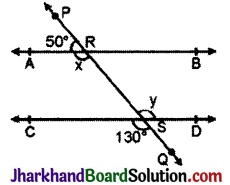
![]()
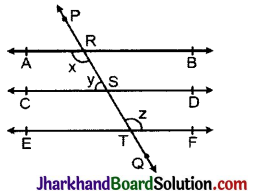
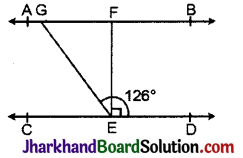
![]()

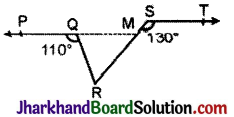
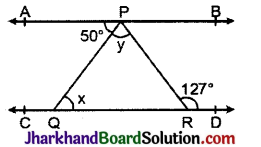
![]()
